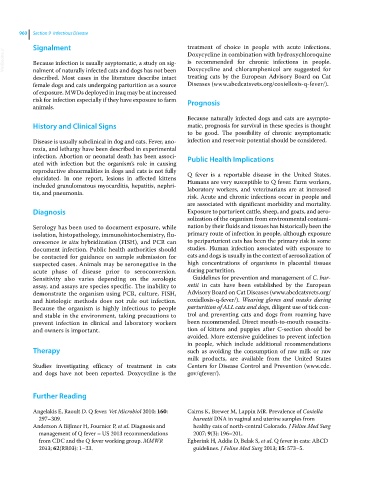Page 1022 - Clinical Small Animal Internal Medicine
P. 1022
960 Section 9 Infectious Disease
Signalment treatment of choice in people with acute infections.
VetBooks.ir Because infection is usually asyptomatic, a study on sig- Doxycycline in combination with hydroxychloroquine
is recommended for chronic infections in people.
Doxycycline and chloramphenicol are suggested for
nalment of naturally infected cats and dogs has not been
described. Most cases in the literature describe intact treating cats by the European Advisory Board on Cat
female dogs and cats undergoing parturition as a source Diseases (www.abcdcatsvets.org/coxiellosis‐q‐fever/).
of exposure. MWDs deployed in Iraq may be at increased
risk for infection especially if they have exposure to farm Prognosis
animals.
Because naturally infected dogs and cats are asympto-
History and Clinical Signs matic, prognosis for survival in these species is thought
to be good. The possibility of chronic asymptomatic
Disease is usually subclinical in dog and cats. Fever, ano- infection and reservoir potential should be considered.
rexia, and lethargy have been described in experimental
infection. Abortion or neonatal death has been associ- Public Health Implications
ated with infection but the organism’s role in causing
reproductive abnormalities in dogs and cats is not fully Q fever is a reportable disease in the United States.
elucidated. In one report, lesions in affected kittens Humans are very susceptible to Q fever. Farm workers,
included granulomatous myocarditis, hepatitis, nephri- laboratory workers, and veterinarians are at increased
tis, and pneumonia.
risk. Acute and chronic infections occur in people and
are associated with significant morbidity and mortality.
Diagnosis Exposure to parturient cattle, sheep, and goats, and aero-
solization of the organism from environmental contami-
Serology has been used to document exposure, while nation by their fluids and tissues has historically been the
isolation, histopathology, immunohistochemistry, flu- primary route of infection in people, although exposure
orescence in situ hybridization (FISH), and PCR can to periparturient cats has been the primary risk in some
document infection. Public health authorities should studies. Human infection associated with exposure to
be contacted for guidance on sample submission for cats and dogs is usually in the context of aerosolization of
suspected cases. Animals may be seronegative in the high concentrations of organisms in placental tissues
acute phase of disease prior to seroconversion. during parturition.
Sensitivity also varies depending on the serologic Guidelines for prevention and management of C. bur-
assay, and assays are species specific. The inability to netii in cats have been established by the European
demonstrate the organism using PCR, culture, FISH, Advisory Board on Cat Diseases (www.abcdcatsvets.org/
and histologic methods does not rule out infection. coxiellosis‐q‐fever/). Wearing gloves and masks during
Because the organism is highly infectious to people parturition of ALL cats and dogs, diligent use of tick con-
and stable in the environment, taking precautions to trol and preventing cats and dogs from roaming have
prevent infection in clinical and laboratory workers been recommended. Direct mouth‐to‐mouth resuscita-
and owners is important. tion of kittens and puppies after C‐section should be
avoided. More extensive guidelines to prevent infection
in people, which include additional recommendations
Therapy such as avoiding the consumption of raw milk or raw
milk products, are available from the United States
Studies investigating efficacy of treatment in cats Centers for Disease Control and Prevention (www.cdc.
and dogs have not been reported. Doxycycline is the gov/qfever/).
Further Reading
Angelakis E, Raoult D. Q fever. Vet Microbiol 2010; 160: Cairns K, Brewer M, Lappin MR. Prevalence of Coxiella
297–309. burnetii DNA in vaginal and uterine samples from
Anderson A Bijlmer H, Fournier P, et al. Diagnosis and healthy cats of north‐central Colorado. J Feline Med Surg
management of Q fever – US 2013 recommendations 2007; 9(3): 196–201.
from CDC and the Q fever working group. MMWR Egberink H, Addie D, Belak S, et al. Q fever in cats: ABCD
2013; 62(RR03): 1–23. guidelines. J Feline Med Surg 2013; 15: 573–5.

